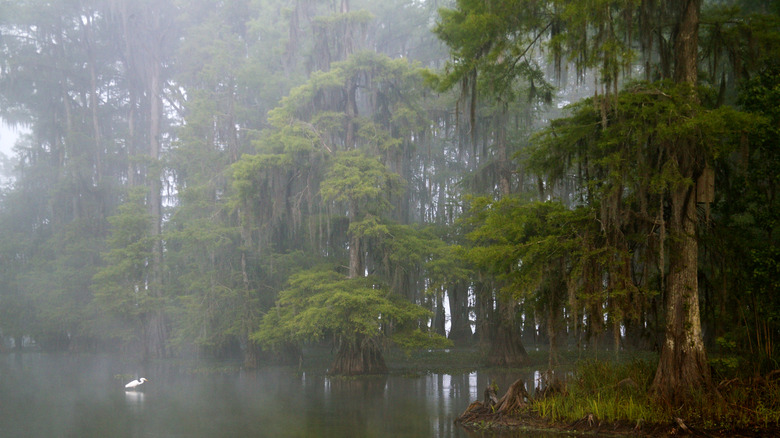Types Of Trees In Swamps
A swamp is an area permanently saturated with fresh water or saltwater, and it's one with nutrient-rich soil that supports a high level of biodiversity. Trees thrive in wetlands, and a swamp is often defined by the types of trees that grow there. For example, cypress swamps are usually dominated by cypress trees, and hardwood swamps are home to various species of ash, maple, and oak. Swamps exist on every continent except Antarctica.
Cypress swamps
The dominant tree in cypress swamps, which are common throughout the Florida Everglades, is the baldcypress (Taxodium distichum), a deciduous conifer that belongs to the redwood family. It consists of two varieties known by such names as pond cypress, swamp cypress, and red, yellow, white, or black cypress. The water tupelo (Nyssa aquatica), also known as the cottongum or swamp tupelo, is a large deciduous tree that also grows in cypress swamps, which are sometimes known as bottomland hardwood forests. Various species of oak (Quercus sp.) also grow there.
Other freshwater swamps
Hardier deciduous species dominate the hardwood swamps in colder climates in North America, including green ash (Fraxinus pennsylvanica), black ash (Fraxinus nigra), silver maple (Acer saccharinum), red maple (Acer rubrum) and various oak species. Floodplain forests, which are fed and drained by the movement of river waters, are home to the eastern cottonwood (Populous deltoides), one of the largest North American hardwood trees. Moving to the Canadian border and beyond, coniferous swamps are populated by eastern white cedar (Thuja occidentalis), tamarack (Larix laricina), or black spruce (Picea mariana) trees. One species typically dominates a given swamp, but all three are usually present.
Saltwater swamps
Saltwater swamps exist on tropical coastlines where tide pools form and high tide inundates beds of sand and fertile mud. A wide variety of trees, all broadly classified as mangroves, are able to thrive in this salt-rich environment. Some, such as the red mangrove (Rhizophora mangle), are true mangroves, but others, such as palm, hibiscus, myrtle, holly, or legumes, are different species altogether. Mangrove stands help stabilize the coastline, and they provide shelter for a variety of aquatic birds and animals and spawning grounds for fish, clams, and other marine creatures.
Shrub swamps
Shrub swamps are similar to forested swamps, and the two are often found next to one another. In fact, some mangrove swamps are actually shrub swamps. In northern climates, shrub swamps are often home to dogwood (Cornus sp.), swamp rose (Rosa palustris), willow (Salix sp.), and buttonbush (Cephalanthus occidentalis). Shrub swamps with a 40% to 60% ratio of open water can shelter various wildlife species, including beavers, muskrats, and different kinds of reptiles and amphibians, according to the Michigan Department of Natural Resources.
